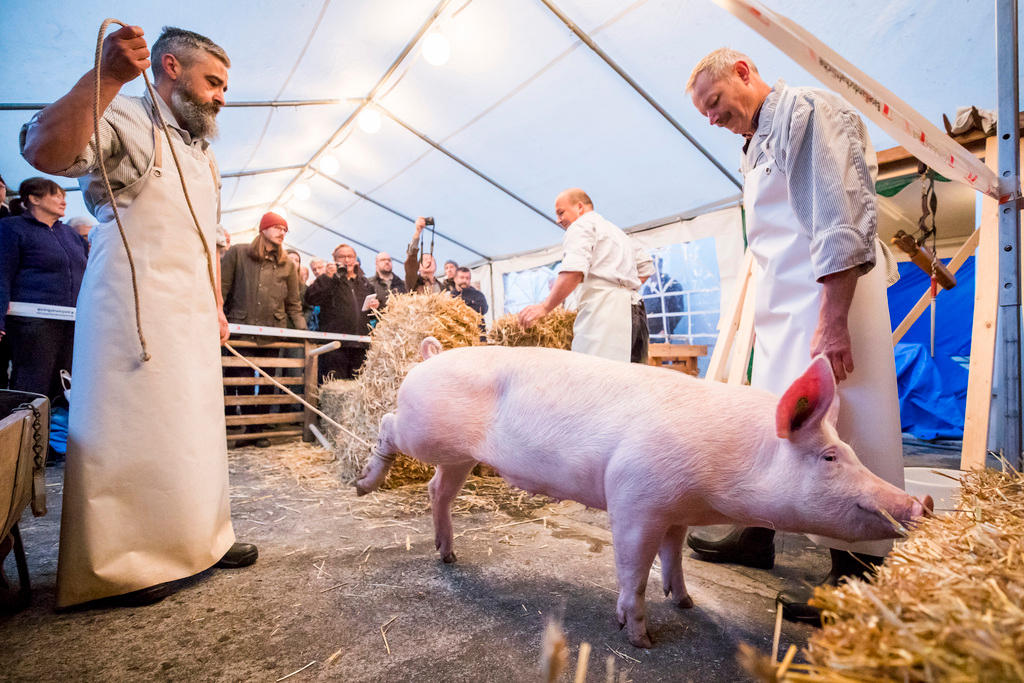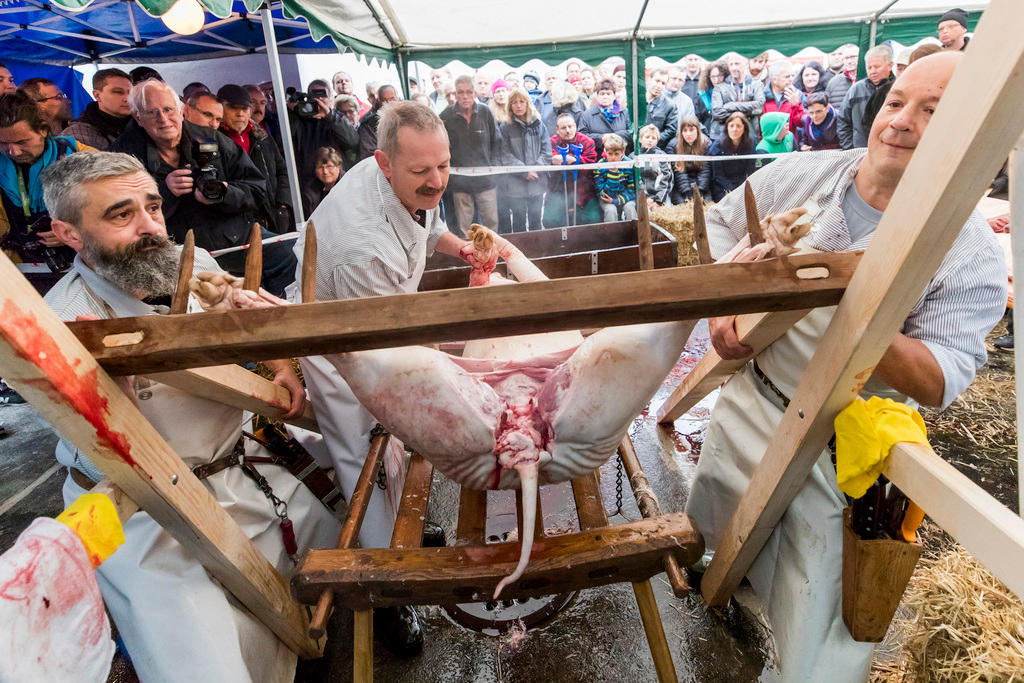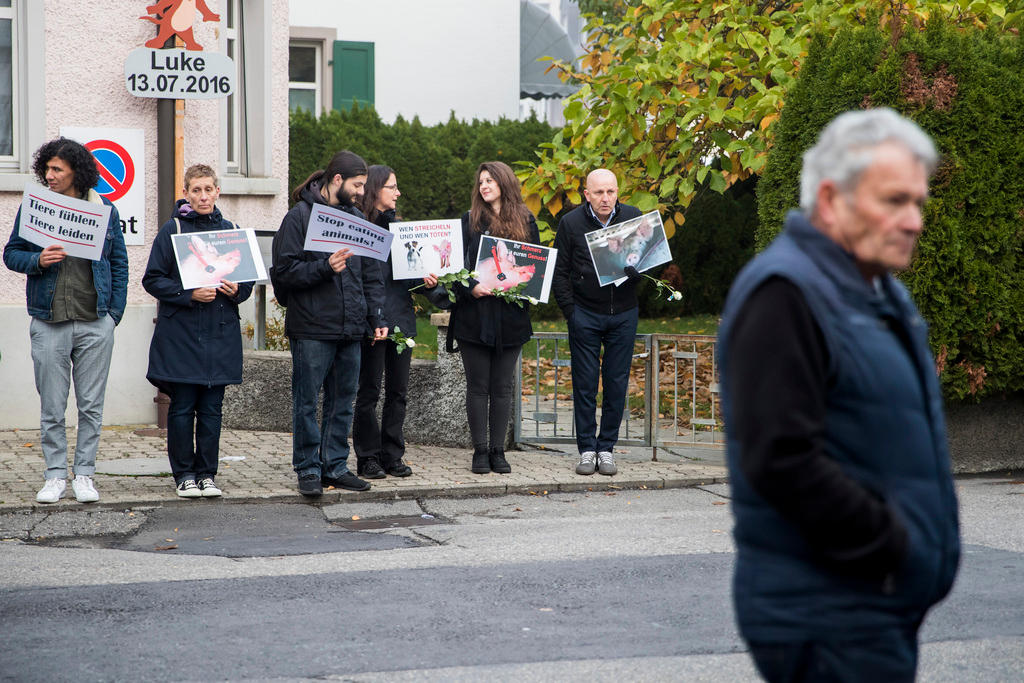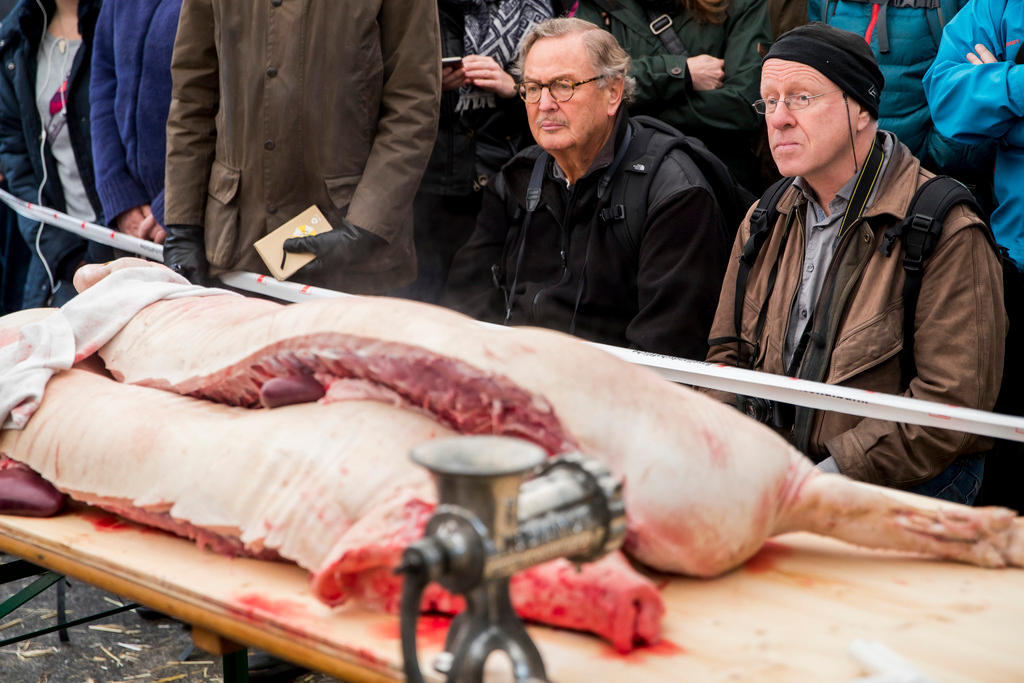
Public slaughter pits Swiss tradition against modern thinking

A local butcher announces that he will slaughter two pigs in public. Animal rights activists cry out, threaten lawsuits and urge the government to ban the action. Does an old tradition still have a place in Swiss society?
A shot rings out. After a few milliseconds, a bullet pierces the pig’s papaya-sized brain. It sends the last signals through the nerve tracts, the pig’s pink legs are twitching in the hay. Two men pick up the heavy corpse. One of them cuts the carotid artery, dark red blood splatters into a white kettle. Small drops stain the butchers’ plastic aprons and the collars of their finely striped shirts.
On this wet Saturday morning, the small village of Sissach in canton Basel Country in the north of Switzerland, sees two pigs publicly slaughtered. This old Swiss custom of public slaughtering usually takes place when the heavy fog has settled on the roofs and the leaves are falling from the trees. The tradition began in the 18th century, when Swiss rural families started to buy two or three pigs in the spring, fattened them during the summer and slaughtered them on their farms in the autumn. After the meat was cooked, cured, smoked and dried, it was usually stored for the harsh winters. Some parts of the offal, which did not keep fresh, were immediately processed. One of the delicacies was black pudding, which is made of fresh pig’s blood.

Public protest
But this rural tradition no longer has its place in Switzerland’s modern society, as reflected in the outcry triggered by the event in Sissach. When the local press announced Rolf Häring’s public slaughtering, which was going to take place on his private property, the editorial pages in the local papers quickly filled with outrage.
People called Häring’s idea sick, saying he was making fun of the tradition and would kill for public entertainment. Häring himself received a threatening letter comparing him to a terrorist, who kills publicly. Even the Swiss Animal ProtectionExternal link organisation got involved, formally requesting that the cantonal government stop the event. The Swiss priest Lukas Baumann, who is known as the ‘rabbit priest’ for setting up a rescue centre for mistreated rabbits, also expressed his opinion. He calls the public slaughtering a degrading and cruel event, which belongs to the last century.

17,000 animals slaughtered per day
This public outcry was felt all over Switzerland, a country where according to the vegetarian organisation SwissvegExternal link more than 60 million animals are slaughtered each year – which translates to 170,000 animals per day. And several tons of meat are imported from abroad each year.
In international terms, Switzerland is far less carnivorous than countries such as Australia, where the per capita meat consumption lies at 120kg. But like everywhere else, meat consumption has risen significantly here. According to the consumer magazine “Beobachter” (Observer), it has doubled over the past 50 years and is now at around 51kg meat per person per year.
Butcher Rolf Häring is startled by the nationwide uproar his public slaughtering has caused. It has even reached as far as Germany. “I only wanted to educate people and revive an old Swiss tradition,” he said. His other intention was to trigger a discussion about the origin of meat. “Is it really more respectful to slaughter a pig in Spain, make it into Parma ham in Ticino and sell it in Poland?” he wondered.
He also points out that at least such a public slaughtering observed the strict Swiss animal rights’ conditions. This, he says, was ensured by a veterinarian being present during the procedure. Häring emphasises that the animals came from an organic farm and killing them with a bullet was much more humane than sedating them with anesthetics, as is done in slaughterhouses. This method often results in animals suffering respiratory stress and fear of suffocation.

Animal welfare lobby protests
But animal rights activists viewed the event differently. On the day of the slaughter, slogans such as “Killing animals for fun?” or “Farm animals are exploited just like a resource” are printed on flyers handed out near the staging area. A handful of people hold up a black banner saying: “Animals feel; animals suffer.” Lit candles line the ground with the slogan “Stop violence for pleasure” written on the pavement.
In the meantime, smoke has started to rise in the courtyard and the smell of singed hair fills the air. One dead pig is lying on a wooden block and butcher Häring is holding a flamethrower in his hands. Two men are using small tools to scrape the bristles off the pig’s body. Rolf Häring moves the orange flame across the animal’s skin to burn off the remaining hairs. The pig is then cut apart with a sharp knife, gutted and hung in order to get the last drops of blood out of the animal’s muscles. Häring carefully explains every step and every move to the public.
Suddenly he extracts something pink from the intestines and holds it up: the pancreas. “This used to be used as a blood-sugar reducing agent,” he says.
He then clutches the round gall bladder between two fingers.
“The older generation may still know this. This used to be turned into ox-gall soap, which is a very efficient cleaning agent.”
Around 100 people, including children, have gathered around to listen and to watch the accomplished butcher ply his trade.
Sausages and lashes
The result of this public slaughtering eventually ends up on our plates. Just as in the old days, the pigs’ parts are made into black pudding as well as liver and grilling sausages, which will then be happily consumed in the party tent next door.
But not everyone is willing to accept this. Two days after the public slaughtering, former priest Lukas Baumann shows up in town, stripped to the waist and holding a whip in his hand.
“I admit that by publicly slaughtering two pigs, injustice has been done in our village,” he exclaims, before lashing the whip across his own bare back in an act of defiance.
Translated from German by Billi Bierling

In compliance with the JTI standards
More: SWI swissinfo.ch certified by the Journalism Trust Initiative




























You can find an overview of ongoing debates with our journalists here . Please join us!
If you want to start a conversation about a topic raised in this article or want to report factual errors, email us at english@swissinfo.ch.